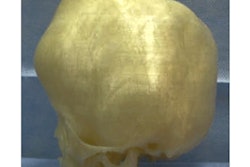
Researchers from California have developed a method for creating individually tailored 3D-printed glasses based on the CT scans of kids with craniofacial defects who are unable to wear standard frames, according to a study published online in the Journal of the American Association for Pediatric Ophthalmology and Strabismus.
The group, consisting of ophthalmologists and neuroradiologists from the University of California, San Francisco (UCSF), recognized the inadequacy of generic glasses frames for pediatric patients presenting with craniofacial malformations, or anomalies, at their institution.
Vision complications are common for patients with craniofacial anomalies, yet the irregular anatomy of these patients makes fitting into a conventional pair of glasses extremely challenging for them, first author Dr. Frank Brodie and colleagues noted. Families often build homemade adaptations with straps to improve the fit, but these run the risk of inducing additional vision complications such as lazy eye.
To help resolve this issue for children with craniofacial anomalies, the researchers developed a new technique for supplying custom-made 3D-printed glasses to patients based on the shape of their face and skull on CT scans (J AAPOS, February 13, 2019).
 3D modeling of CT scans for 3D-printed glasses. Image courtesy of Dr. Frank Brodie.
3D modeling of CT scans for 3D-printed glasses. Image courtesy of Dr. Frank Brodie.In one particular case, Brodie and colleagues acquired the CT scans of a 3-year-old girl with ear asymmetry, a flattened nasal bridge, and several other facial and skull malformations who underwent multiple corrective eye surgeries. They used volume-rendering software to create a 3D virtual model of the patient's face and skull and then converted the file into stereolithography (STL) format.
A team of eyewear designers used this 3D image file to design a virtual pair of glasses that would accommodate the patient's distinct anatomy -- including nonstandard distances from the nasal bridge to the eyes and ears and an abnormal head curvature -- while avoiding unnecessary skin contact.
Using the virtual design, the researchers created 3D-printed glasses tailored specifically for the patient with a 3D printer (Ultimaker 2+, Ultimaker). They also created a larger pair of glasses to account for the patient's growth, using flexible resin material and a higher-resolution 3D printer (Form 2, Formlabs), which they later fitted with optical lenses. The approximate cost of the frames was $12.
"We showed CT scans could be reconstructed to skin-level models upon which custom spectacles could be designed for children who previously were unable to find any glasses that fit them," Brodie told AuntMinnie.com. "This holds the potential to decrease the risk of amblyopia and vision loss in this patient population. The radiology team at UCSF was instrumental in developing the techniques to provide the skin-level reconstruction of the existing CT scans and later to help us export these scans into a format that could be used by glasses designers."
Since the time of the study's publication, the group has collaborated with the Loving Eyes Foundation to provide 3D-printed glasses for several children with craniofacial anomalies. The researchers plan to expand this program as they continue improving aspects of their technique, from automating the design process to using other imaging modalities to visualize patient anatomy.



















